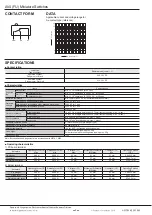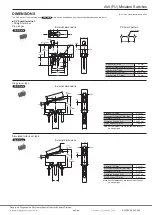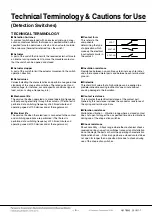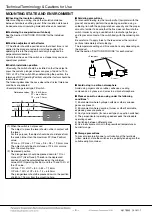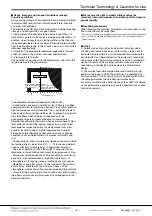
Technical Terminology & Cautions for Use
AECTB36E 201811-T
MOUNTING STATE AND ENVIRONMENT
■
Checking the insulation distance
After mounting and wiring, check the insulation distance
between terminals and the ground. If the insulation distance is
inadequate, mount insulating material between as required.
■
Fastening the snap-action switch body
See the Section “CAUTIONS FOR USE” for the individual
switch.
■
Position adjustment with effector
1) The effector should be positioned so that direct force is not
applied to the plunger or actuator in its free position. The
operating force to the plunger should only be applied in a
perpendicular direction.
2) Note that the use of the switch as a stopper may cause an
operational problem.
■
Switch installation position
• Basically, the switch should be installed so that the object to
press the switch’s plunger or lever can press it down to 70 to
100% of OT of the switch. When determining the position, the
tolerance of OP (Operating Position) and other factors should be
taken into account.
The following describes the case where the strictest tolerance
conditions are adopted.
• Example: Hinge lever type FS switch
■
Soldering precautions
For manual soldering, lay the terminals flat (horizontal with the
ground) and quickly perform the soldering operation using a
soldering iron with the appropriate heat capacity and the proper
amount of solder. Take care that the flux does not flow into the
switch interior by using a ventilation fan to discharge flux gas
and to prevent contact of the switch body with the soldering iron
tip.
Be careful not to apply force to the lead wires or the terminal
portions immediately after soldering.
The temperature setting and time conditions vary depending on
the product.
See the section “CAUTIONS FOR USE” for each product.
■
Avoid using in a silicon atmosphere
Avoid using organic silicon rubber, adhesives, sealing
compounds, oil, grease, and wires in a silicon atmosphere.
■
Please consult us when using under the following
conditions*:
1) Environments where hydrogen sulfide or other corrosive
gases are present.
2) Environments where gasoline, thinner or other flammable,
explosive gases are present.
3) Dusty environments (for non-seal type snap action switches).
4) The perpendicular operating speed exceeds the allowable
operating speed.
5) Switching between different poles.
6) Use in environments not in the prescribed temperature or
humidity range.
■
Storage precautions
To prevent discoloration due to sulfurization of the terminals
(silver- plated), store the switches in a polyethylene bag or other
suitable airtight container.
(1) When the switch is not pressed
The object to press the lever should not be in contact with
the lever.
For this purpose, the object should be at a distance from
the switch father than the maximum FP (Free Position)
value.
FP max = OP max + PT max = 9.6 + 2.8 = 12.4 mm max
The object should be at a distance of 12.4 mm or more
from the mounting hole.
(2) Depressed position
The plunger/lever should be pressed down to 70% or
more of OT (Over Travel). Therefore, the depressed
position should be calculated based on the minimum
value of OP (Operating Position) and the 70 and 100% of
the OT value.
OP min - 70% of OT = 8.0 - 0.84 = 7.16 mm
OP min - 100% of OT = 8.0 - 1.2 = 6.80 mm
The plunger/lever should be pressed down to the position
of 6.80 to 7.16 mm from the mounting hole.
FP
OP
PT
TTP
OT
Reference values: OP = 8.8
±
0.8mm
PT = max. 2.8mm
OT = min. 1.2mm
<Examples>
Soldering iron tip
Wrong
Correct
ー 9 ー
Содержание AV4
Страница 12: ...2019 AECTB16E 1 201903 ...


